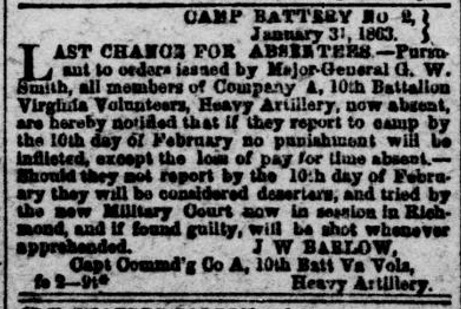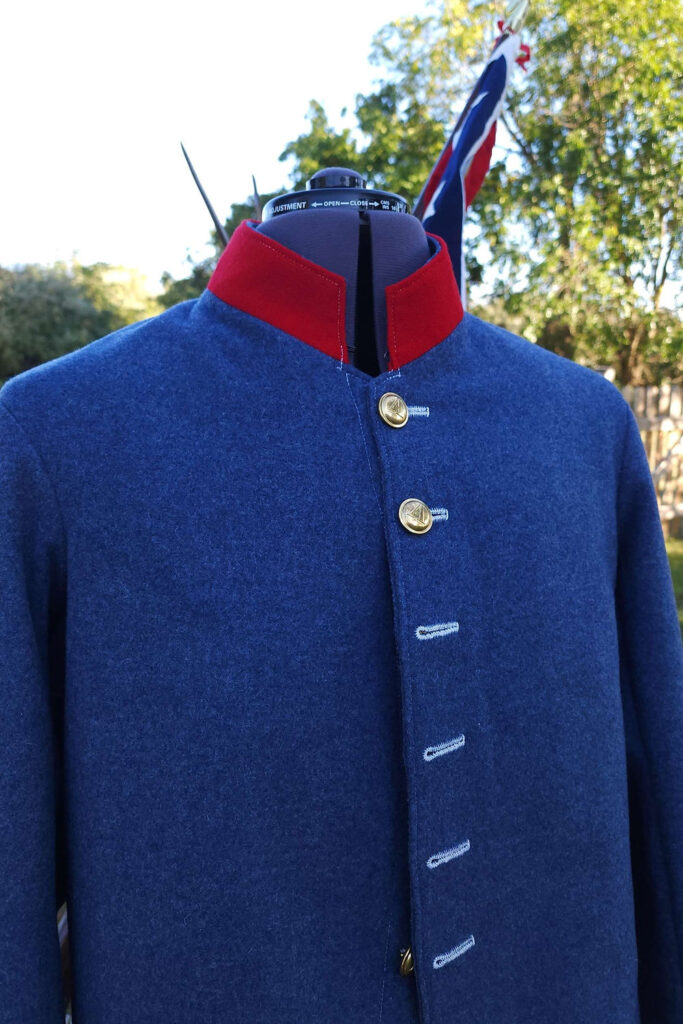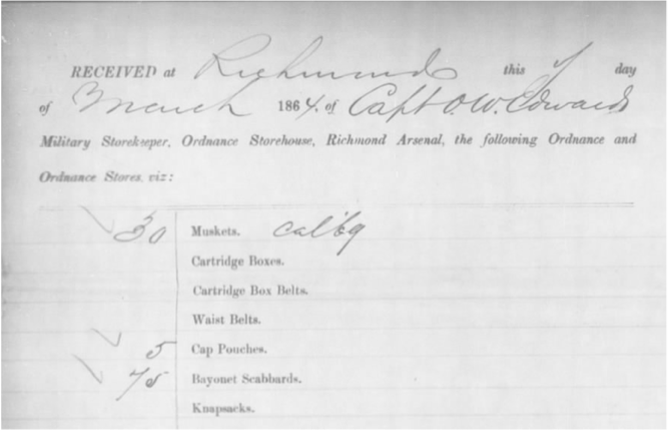
Brief History of the Battalion
The 10th Battalion Virginia Heavy Artillery was formally organized at Richmond on April 4, 1862, with five companies under the command of Major William Allen that had previously served at Jamestown Island. After Allen resigned in August 1862, command of the battalion fell to Major James O. Hensely. The unit served in the Department of Richmond, where it served alongside the 19th Battalion Virginia Heavy Artillery under the unified command of Lieutenant Colonel John Wilder Atkinson. In addition to manning the heavy artillery guns, the over 500 man battalion was also trained as infantry and armed with muskets. It was lightly engaged on several occasions when Federal raiders approached Richmond. It was involved in the Richmond defenses at Brook’s Turnpike and at Drewry’s Bluff. In 1865 the battalion was transferred as infantry to the Army of Northern Virginia as part of the Artillery Brigade commanded by Col. Stapleton Crutchfield. The unit took part in the Appomattox Campaign, suffered significant casualties at Sailor’s Creek, and surrendered at Appomattox with 103 officers and men.
Battalion Organization at Sailor’s Creek
The following is based on a comprehensive review of the compiled service records of the battalion’s officers and review of primary sources. The whereabouts of several officers at the time of Sailor’s Creek could not be verified, as there was no record of them being killed, captured, or absent, but they did not surrender at Appomattox. It is possible they were separated from the unit during the retreat or were otherwise absent.
Field and Staff
Major James O. Hensley: status unclear
Adjutant 1st LT Samuel Wilson: wounded and captured at Sailor’s Creek
SGT Major James S. Mill: captured at Sailor’s Creek
Acting AQM 1st LT Robert T. Aunspaugh (Co B.): status unclear
QM SGT James H. Hargrave: status unclear
Ordnance SGT Arthur S. Johns: status unclear
Co. A AKA Metropolitan Guards (Color Company)
Organized from Richmond
Cap. Joseph W. Barlow: killed at Sailor’s Creek
1st LT William L. Satterwhite: status unclear
2nd LT Michael G. Whitman: status unclear
3rd LT Thomas Russell: Deserted 30 Mar 1865
Co. B
Organized from Bedford County
Cap. Robert B. Claytor: captured
1st LT Robert T. Aunspaugh: acting AQM, status unclear
2nd LT Samuel Crawford: surrendered at Appomattox
3rd LT Leslie C. Talbot: captured at Sailor’s Creek
Co. C AKA Allen Artillery
Organized from Richmond
Cap. Thomas P. Wilkinson: captured at Sailor’s Creek
1st LT John W. Turner: captured at Sailor’s Creek
2nd LT John R. Winder: likely separated during retreat
3rd LT William B. G. Andrews: captured at Sailor’s Creek
Co. D AKA Jamestown Heavy Artillery AKA Brandon Light Artillery AKA Surry Heavy Artillery
Organized from Surry and Prince George Counties
Cap. Charles Shirley Harrison: captured at Sailor’s Creek
1st LT Joseph M. Green: separated during retreat
2nd LT James E. Gray: surrendered at Appomattox
3rd LT Aurelius P. Bohannon: captured at Sailor’s Creek
Co. E
Organized from Henrico County
Cap. Thomas B. Blake: wounded and captured at Sailor’s Creek
1st LT Robert E. Binford: separated during retreat
2nd LT John Armistead Allen: likely captured during fall of Richmond
3rd LT Gustavus Gary: surrendered at Appomattox
Essential Reading
10th Battalion Virginia Artillery and Sailor’s Creek
Retreat from Richmond – By Thomas Blake, Captain Commanding 10th Battalion Virginia Heavy Artillery Co. E
The Artillery Brigade: Its Heroic Conduct at Sailor’s Creek—Additional Details – By Thomas Blake, Captain Commanding 10th Battalion Virginia Heavy Artillery Co. E
Crutchfield’s Artillery Brigade – by William Basinger, Major Commanding 18th Battalion Georgia Heavy Artillery
Uniforms
The Confederate Soldier at Fort Mahone, Battle of Petersburg, April 2, 1865 – By Fred Adolphus
Prisoners of Grant – The “Punch Bowl” Photo – By James Schruefer
A Survey of Confederate Central Government Quartermaster Issue Jackets, Part 1 – By Les Jensen
A Survey of Confederate Central Government Quartermaster Issue Jackets, Part 2 – By Les Jensen
Richmond Depot Jackets: Characteristics, Anomalies, & Myths – By Richard Milstead
Richmond Depot Clothing – Vol. II – By Richard Milstead
Striped Shirts and Slop Sellers: British Import Shirts in the Army of Northern Virginia – By Austin Williams
English Supplied Uniforms in the Army of Northern Virginia – By Eric Mink
The Quintessential Confederate Cap: Part II, Caps of the Richmond Clothing Bureau – By Fred Adolphus
Francis M. Durham “Peter Tait” Imported Jacket, and More… – By Fred Adolphus
The Imported British Overcoat for the Confederate Army – By Fred Adolphus
Peter Tait Trousers Finally Surface: Alabama Tait Contract Artillery Trousers – By Fred Adolphus
Thoughts on Red Tait Jackets – By Christopher Daley
John & George Gibson: Wooden Buttons for the Richmond Depot – By James Schruefer
John and George Gibson, House Carpenters and Builders – Providers of Buttons for the Richmond Clothing Bureau – By Richard Milstead
Equipment
Biscuit Bakers and Camp Kettles: Notes on Confederate Mess Equipment – By Craig Schneider
Fly Tents and Shelter Halves: Confederate Tent Production in Richmond – By Craig Schneider
A Photographic Analysis of Federal Canteens in Confederate Service 1863-1865 – By John Stillwagon




